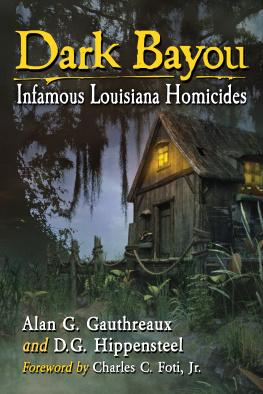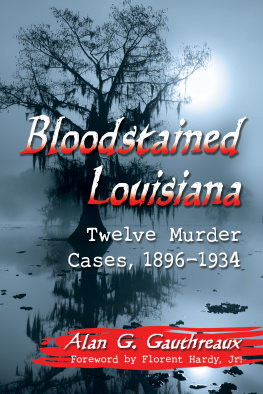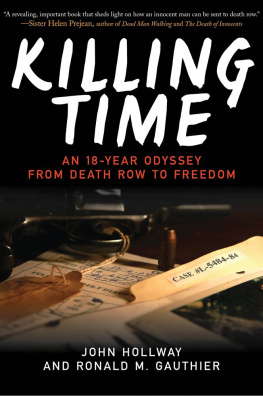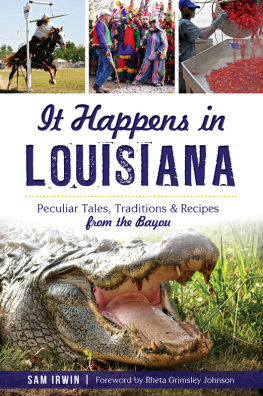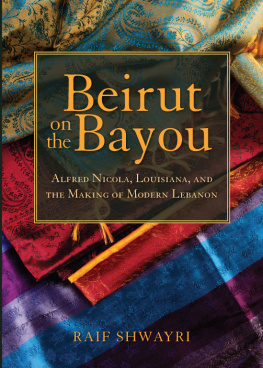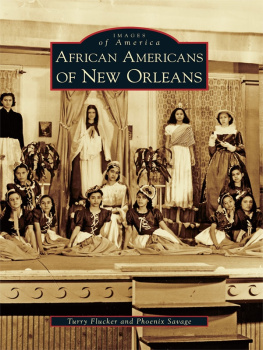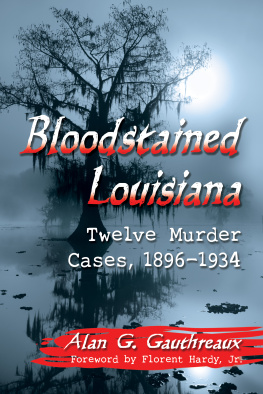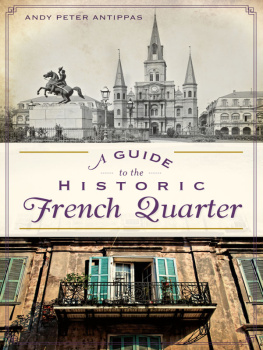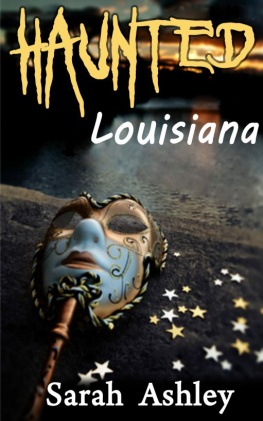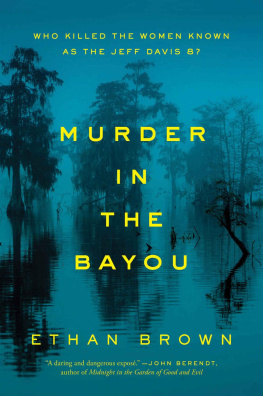
Dark Bayou
Infamous Louisiana Homicides
Alan G. Gauthreaux and D.G. Hippensteel
Foreword by Charles C. Foti, Jr.

McFarland & Company, Inc., Publishers
Jefferson, North Carolina
ISBN 978-1-4766-2296-5 (ebook)
LIBRARY OF CONGRESS CATALOGUING DATA ARE AVAILABLE
BRITISH LIBRARY CATALOGUING DATA ARE AVAILABLE
2016 Alan G. Gauthreaux and D.G. Hippensteel.
All rights reserved
No part of this book may be reproduced or transmitted in any form or by any means, electronic or mechanical, including photocopying or recording, or by any information storage and retrieval system, without permission in writing from the publisher.
Front cover image 2016 iStock/Thinkstock
McFarland & Company, Inc., Publishers
Box 611, Jefferson, North Carolina 28640
www.mcfarlandpub.com
So the victims will not be forgotten
Acknowledgments
The authors would like to acknowledge the following individuals who selflessly assisted with the production of this work:
The Honorable Charles C. Foti, Jr., for his insight and the foreword; the Rev. Dr. Craig W. Rinker, for his constant loving life posture, his ability to make the heart and spirit of Scripture come alive, and his ever-present talent in giving comfort to others; Dr. Edward P. St. John, for his lifetime example of believing in students, the process of education, and continued research; Dr. Florent Hardy, Louisiana State archivist, for his inspiration, tutelage, and assistance with primary materials; Bill Stafford, assistant archivist with the State of Louisiana; John Fowler, assistant archivist with the State of Louisiana; Dr. Florence Jumonville, archivist at the University of New Orleans, Earl K. Long Library; Connie Phelps, librarian in Special Collections at the University of New Orleans, Earl K. Long Library; Al Barron, director of the Washington Parish Public Library and fellow East Jefferson High School alumnus; Mary Wenet, archivist, Northwestern State University; Winola Holliday, whose recollections of Bogalusas past helped put the history of Washington Parish in a humanistic perspective; Irene Wainwright, former chief archivist at the New Orleans Public Library, Special Collections Division, who never ceases to amaze with her research acumen; Yvonne Loiselle, current chief archivist of the Special Collections Division of the New Orleans Public Library, whose special assistance with the photograph collection proved extremely helpful; Randy Country Seal, sheriff of Washington Parish, whose professionalism, candor, and assistance with parts of this work proved instrumental; W. J. LeBlanc, attorney at law, for his insight into the workings of the criminal justice system as they pertained to one of the most bizarre murder trials in recent local memory; Col. Joseph D. Passalaqua (ret.), Jefferson Parish Sheriffs Office, former chief of the Crime Scene Division; John Fox, historian with the Federal Bureau of Investigation; Patricia L. Lloyd, whose interesting and intelligent viewpoints kept our historical assumptions honest; Shelley Fairbanks, a formidable student and intellectually honest supporter; Allison J. Pitcher, a friend, supporter, and admirer of literature who left this world too soon, and who encouraged not only literary works, but other artistic endeavors in and around the city of New Orleans; and Lisa Gauthreaux, for her patience with research trips to strange destinations on a limited budget.
Foreword by Charles C. Foti, Jr.
In the United States as a whole, the murder rate has been cut nearly in half in the last four decades, falling from 7.9 murders per 100,000 people in 1970 to 4.5 murders per 100,000 in 2013. Louisiana has been part of this trendthe states homicide rate fell from 17.5 per 100,000 in 1996 to 10.8 per 100,000 in 2013but it continues to be plagued by the highest homicide rate in the country.
Murder harms society in many ways. Not only do the victims suffer directly, but their families, friends, and the community also bear the indirect burden of such crimes. Fear swells and people begin to feel unsafe, threatened, and hopeless. The justice system moves at a slow and deliberate pace. Further, the process of reaching a conviction and doling out a sentence, at least when the proceedings are hampered by weak, circumstantial, or tainted evidence and poor or questionable witnesses, does not always lend itself to an outcome that seems equitable, for either the justice system or the victim.
The cases highlighted by Alan G. Gauthreaux and D. G. Hippensteel in this book illustrate the elements of killing, though the perceived gain or justification for the assailant differs in each case. The cases portray numerous murders that occurred in New Orleans, Crowley, Bogalusa, Varnado, Metairie, and as far north as Lake Charles. Gauthreaux and Hippensteel take the reader on a journey of history and criminology through a myriad of murders across time and place: the origins of the first Mafia don; the sinister assassinations of police chiefs that began in the late 1800s; the tragic case of a notorious madam whose paramour sought to relieve her of her fortune; ritual murders influenced by a teen-aged cult leader; a cold, calculating, methodical personality with sociopathic traits accused of using morphine to kill a close family member in a case motivated by greed; an enlightening reassessment of the assassination of Sen. Huey P. Long; racially charged murders that defined a volatile period in Louisiana (and U.S.) history; the true case of a Jefferson Parish housewife who succumbed to one of the most brutal deaths in Louisiana history; and the truly inexplicable case of a well-known local television personality whose ego convinced him he would be spared from life imprisonment for the murder of his wife. All of these cases keenly illustrate the history, culture, and written law of the time, and they provide insightful historical views of criminal justice procedure and development. Perhaps even more importantly, these cases are truly intriguingbut perhaps little rememberedevents that beg for a more complete and unbiased assessment.
In Dark Bayou, Gauthreaux and Hippensteel offer readers of this genre a fascinating peek not only into time, and not only into the criminal justice system, but into the dark side of the primal psyche. As the criminal sheriff in New Orleans for more than 30 years, the former attorney general of the State of Louisiana, a prosecutor, and defense counsel, I well realize some of the underlying motivations for murder are emotional, social, religious, economic, educational, political, greed, anger, self-defense, alcohol and drugs, revenge, jealousy, and domestic abuse. Gauthreaux and Hippensteel chose cases that illustrate some of these core causes of murder, and they integrate an unbiased historical precision in describing these cases with their desire to appeal to a mass audience in accomplishing that objective. Dark Bayou deservedly belongs among the most important works within the shadowy realm of true crime.
The Honorable Mr. Charles C. Foti, Jr., is a partner with the law firm of Kahn, Swick, & Foti, LLC, in Madisonville, Louisiana, and an advocate for humanitarian causes. He was the sheriff of the Orleans Parish Criminal Sheriffs Office from 1974 to 2003 and was elected Louisiana attorney general in 2004, serving until 2008.
Preface
Dark Bayou began as an historical interest in the peculiar and ghastly, but evolved into an historical and social study of serious crimes in the annals of Louisiana history. The authors realized that a fascination existed with humans dark imagination and its relation with the unknown, unsolved, or controversial. In Louisiana, there have been several incidents where Truth is stranger than fictionand the cases profiled in
Next page
